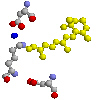
|
Molecular structures: Pores - Channels - Transport |
|

|
Molecular structures: Pores - Channels - Transport |
|
| UHH > Faculty of Biology > Teaching Stuff > Highlights of Biochemistry > Pores - Channels - Transport > Active Transport > Rhodopsins | search |
| View into the cytolpasm on trimeric bacteriorhodopsin from Halobacterium salinarum
|
|
Bacteriorhodopsin from Halobacterium salinarum
|
|
Halorohodopsin from Halobacterium salinarum
|
Both transport and phototaxis perform energy transduction by rhodopsins, which despite their different tasks share very similar molecular structures. The light receptor is a retinal molecule coupled to a conserved lysin in form of a Schiff base, with the supporting protein inserted into the cytoplasmic membrane with seven transmembrane helices. The arrangement of these seven transmembrane helices pertained through evolution in the form of G-protein coupled receptors not only for visual pigments but for other kinds of sensory systems too. A photoinduced change of the retinal's stereochemical conformation is amplified by the protein either to translocate solutes across the membrane or to trigger signal transduction to associated proteins.
In Halobacterium salinarum (recently renamed from Halobacterium halobium or Halobacterium salinarium) four distinct rhodopsins are found. Besides the pumps transporting proteins to the outside or chloride ions into the cytoplasm there are two sensory systems directing movement away from blue-green light (phoborhodopsin) or towards orange light by associated transducer proteins which regulate the flagellar motor switch.
Structural investigations on the proton pumping bacteriorhodopsin were done on different states of the protein: electron diffraction on single layers of the purple membrane of the bacteria led to a first molecular model (which is shown here in the refinement of 1996). Later X-ray experiments with crystals of the protein in different reaction states gave more insight into the reaction mechanism. Both methods show the trimeric native state of the pump (with maybe some limitations due to packing effects in the crystals). NMR methods (or magnetic relaxation dispersion) reveal details of solubilized single molecules trapped in micelles of nonionic detergent. The crystal structure of the chloride pump halorhodopsin shows how the same construction principle is used for a reverse mass transport.